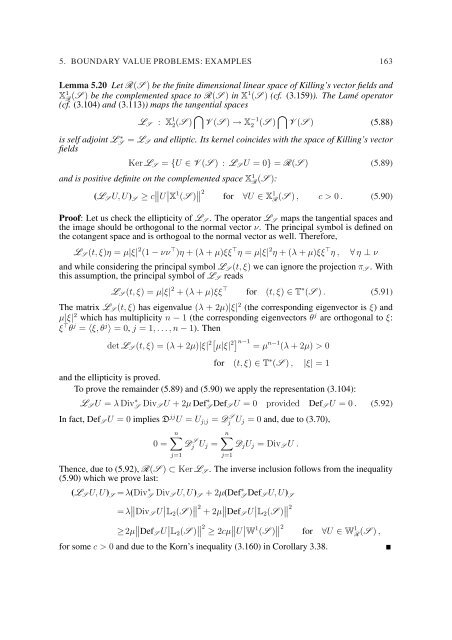EQUATIONS OF ELASTIC HYPERSURFACES
EQUATIONS OF ELASTIC HYPERSURFACES
EQUATIONS OF ELASTIC HYPERSURFACES
You also want an ePaper? Increase the reach of your titles
YUMPU automatically turns print PDFs into web optimized ePapers that Google loves.
5. BOUNDARY VALUE PROBLEMS: EXAMPLES 163<br />
Lemma 5.20 Let R(S ) be the finite dimensional linear space of Killing’s vector fields and<br />
X 1 R (S ) be the complemented space to R(S ) in X1 (S ) (cf. (3.159)). The Lamé operator<br />
(cf. (3.104) and (3.113)) maps the tangential spaces<br />
L S<br />
: X 1 2(S ) ⋂ V (S ) → X −1<br />
2 (S ) ⋂ V (S ) (5.88)<br />
is self adjoint L ∗ S = L S and elliptic. Its kernel coincides with the space of Killing’s vector<br />
fields<br />
Ker L S = {U ∈ V (S ) : L S U = 0} = R(S ) (5.89)<br />
and is positive definite on the complemented space X 1 R (S ):<br />
(L S U, U) S ≥ c ∥ ∥ U<br />
∣ ∣X 1 (S ) ∥ ∥ 2 for ∀U ∈ X 1 R(S ) , c > 0 . (5.90)<br />
Proof: Let us check the ellipticity of L S . The operator L S maps the tangential spaces and<br />
the image should be orthogonal to the normal vector ν. The principal symbol is defined on<br />
the cotangent space and is orthogoal to the normal vector as well. Therefore,<br />
L S (t, ξ)η = µ|ξ| 2 (1 − νν ⊤ )η + (λ + µ)ξξ ⊤ η = µ|ξ| 2 η + (λ + µ)ξξ ⊤ η ,<br />
∀ η ⊥ ν<br />
and while considering the principal symbol L S (t, ξ) we can ignore the projection π S . With<br />
this assumption, the principal symbol of L S reads<br />
L S (t, ξ) = µ|ξ| 2 + (λ + µ)ξξ ⊤ for (t, ξ) ∈ T ∗ (S ) . (5.91)<br />
The matrix L S (t, ξ) has eigenvalue (λ + 2µ)|ξ| 2 (the corresponding eigenvector is ξ) and<br />
µ|ξ| 2 which has multiplicity n − 1 (the corresponding eigenvectors θ j are orthogonal to ξ:<br />
ξ ⊤ θ j = 〈ξ, θ j 〉 = 0, j = 1, . . . , n − 1). Then<br />
det L S (t, ξ) = (λ + 2µ)|ξ| 2[ µ|ξ| 2] n−1<br />
= µ n−1 (λ + 2µ) > 0<br />
for (t, ξ) ∈ T ∗ (S ) , |ξ| = 1<br />
and the ellipticity is proved.<br />
To prove the remainder (5.89) and (5.90) we apply the representation (3.104):<br />
L S U = λ Div ∗ S Div S U + 2µ Def ∗ S Def S U = 0 provided Def S U = 0 . (5.92)<br />
In fact, Def S U = 0 implies D jj U = U j;j = D S j U j = 0 and, due to (3.70),<br />
0 =<br />
n∑<br />
Dj S U j =<br />
j=1<br />
n∑<br />
D j U j = Div S U .<br />
j=1<br />
Thence, due to (5.92), R(S ) ⊂ Ker L S . The inverse inclusion follows from the inequality<br />
(5.90) which we prove last:<br />
(L S U, U) S = λ(Div ∗ S Div S U, U) S + 2µ(Def ∗ S Def S U, U) S<br />
= λ ∥ ∥ DivS U ∣ ∣ L2 (S ) ∥ ∥ 2 + 2µ ∥ ∥ DefS U ∣ ∣ L2 (S ) ∥ ∥ 2<br />
≥2µ ∥ ∥ DefS U ∣ ∣ L2 (S ) ∥ ∥ 2 ≥ 2cµ ∥ ∥ U<br />
∣ ∣W 1 (S ) ∥ ∥ 2 for ∀U ∈ W 1 R(S ) ,<br />
for some c > 0 and due to the Korn’s inequality (3.160) in Corollary 3.38.

















